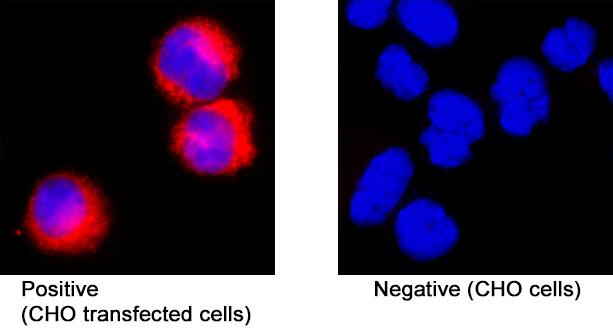MERS-CoV Spike S1 Subunit Antibody
R&D Systems, part of Bio-Techne | Catalog # MAB10707

Key Product Details
Species Reactivity
MERS-CoV
Applications
Immunocytochemistry
Label
Unconjugated
Antibody Source
Monoclonal Mouse IgG1 Clone # 1038459
Product Specifications
Immunogen
Spodoptera frugiperda insect ovarian cell line Sf21-derived MERS-CoV-2 Spike S1
Met1-Pro747
Accession # K9N5Q8.1
Met1-Pro747
Accession # K9N5Q8.1
Specificity
Detects MERS-CoV-2 Spike S1 in ELISA.
Clonality
Monoclonal
Host
Mouse
Isotype
IgG1
Scientific Data Images for MERS-CoV Spike S1 Subunit Antibody
MERS Spike S1 Subunit in CHO Cell Line Transfected with MERS Spike S1.
Spike S1 Subunit was detected in immersion fixed CHO Chinese hamster ovary cell line transfected with MERS Spike S1 (positive staining) and CHO Chinese hamster ovary cell line (non-transfected, negative staining) using Mouse Anti-MERS-CoV Spike S1 Subunit Monoclonal Antibody (Catalog # MAB10707) at 8 µg/mL for 3 hours at room temperature. Cells were stained using the NorthernLights™ 557-conjugated Anti-Mouse IgG Secondary Antibody (red; NL007) and counterstained with DAPI (blue). Specific staining was localized to cytoplasm. View our protocol for Fluorescent ICC Staining of Non-adherent Cells.Applications for MERS-CoV Spike S1 Subunit Antibody
Application
Recommended Usage
Immunocytochemistry
8-25 µg/mL
Sample: Immersion fixed CHO Chinese hamster ovary cell line transfected with MERS Spike S1
Sample: Immersion fixed CHO Chinese hamster ovary cell line transfected with MERS Spike S1
Formulation, Preparation, and Storage
Purification
Protein A or G purified from hybridoma culture supernatant
Reconstitution
Reconstitute at 0.5 mg/mL in sterile PBS. For liquid material, refer to CoA for concentration.
Formulation
Lyophilized from a 0.2 μm filtered solution in PBS with Trehalose. *Small pack size (SP) is supplied either lyophilized or as a 0.2 µm filtered solution in PBS.
Shipping
Lyophilized product is shipped at ambient temperature. Liquid small pack size (-SP) is shipped with polar packs. Upon receipt, store immediately at the temperature recommended below.
Stability & Storage
Use a manual defrost freezer and avoid repeated freeze-thaw cycles.
- 12 months from date of receipt, -20 to -70 °C as supplied.
- 1 month, 2 to 8 °C under sterile conditions after reconstitution.
- 6 months, -20 to -70 °C under sterile conditions after reconstitution.
Background: Spike S1 Subunit
References
- Bermingham, A. et al. (2012) Euro Surveill. 17:20290.
- Zaki, A.M. et al. (2012) N. Engl. J. Med. 367:1814.
- Li, Y. et al. (2019) Engineering. 5:940.
- Raj, V.S. et al. (2013) Nature 495:251.
- Lu, G. et al. (2013) Nature 500:227.
- Wang, N. et al. (2013) Cell. Res. 23:986.
- Corti, D. et al. (2016) J. Infect. Public Health 9:231.
- Tang, X.C. et al. (2014) Proc. Natl. Acad. Sci. USA 111:E2018.
- Jiang, L. et al. (2014) Sci. Transl. Med. 6:234ra59.
Long Name
Spike Protein, S1 Subunit
Alternate Names
SARS-CoV-2
UniProt
Additional Spike S1 Subunit Products
Product Documents for MERS-CoV Spike S1 Subunit Antibody
Product Specific Notices for MERS-CoV Spike S1 Subunit Antibody
For research use only
